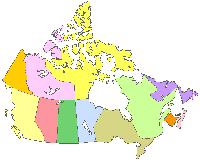Comments > National
From Cheryl Lynch of the Federal Department of Fisheries and Oceans:
NRCAN regulations for distribution of 1:250,000 and 1:50,000 basemaps over the Internet are currently preventing us from making DFO data available spatially over the web. This at a time when"...The Government of Canada is also working to become a model user of the Internet by 2004, to ensure that Canadians will be able to access all government information and services online..."quoted from Nov. 23, 1999 speech by Minister of Industry John Manley.
From an anonymous manager at Natural Resources Canada:
The cost recovery policies of NRCAN make it virtually impossible for us to distribute our digital geological maps with a topographic base. This creates an unacceptable inconvenience and expense to our clients who must obtain the topography separately, and is a major embarassment to us as a federal agency agency.
From another anonymous employee of Natural Resources Canada:
I wish you good luck in your quest to help the Federal Government see that charging royalties is a tremendous handicap to the growth of GIS and geomatics in Canada. It is a shame that 30 years ago we were world leaders and today our brightest minds in geomatics find employment in the U.S. I am relatively certain that the lost tax revenues are far greater than the royalties received.A few examples of how royalties needlessly complicate our lives:
I prefer to remain anonymous if you choose to post this message. I get into enough trouble voicing my opinion at work.including royalty data on a CD with non-royalty data involves data encryption and specialized viewing software
joint Federal/Provincial publications are complicated since Provincial governments do not have the infrastructure or mandate to collect royalties for the Federal government
the same data has different values to different people and there is no way to accomodate for this in any pricing structure. For example, contours and DEM's might be worth thousands of dollars to a hydrologist who might want to perform sophisticated analysis but less than $20 to a geologist who might want to plot the contours on a geology map.
From another anonymous employee of Natural Resources Canada:
When we deliver digital geophysical, geochemical & geological data to our clients, we can not include a simple topographic layer with the data, because we would have to charge a high fee for it to send back to Geomatics Canada. Sure, we have topo layers for in-house use, but we can not redistribute them. If our clients can't locate themselves on geophysical maps, it really hampers their usefulness and makes interpretation awkward. Why should our clients be forced to order the topo data from Geomatics and then deal with importing it into their GIS (and reprojecting if necessary) when we already have done the work and it's ready to use?
From Andrew Makepeace of the Geological Survey of Canada, in Vancouver:
In compiling a geological GIS data set for the Geological Survey of Canada I wanted to include Geomatics Canada's topographic base map coverages. I am unable to do this as I would have to charge as much as Geomatics does for the data, making the cost prohibitive.This is frustrating as I work for an agency in the same ministry as Geomatics Canada! In fact, even for internal use we must purchase Geomatics topo data!!
The result: we use less accurate Digital Chart of the World data instead.
Comments > National
